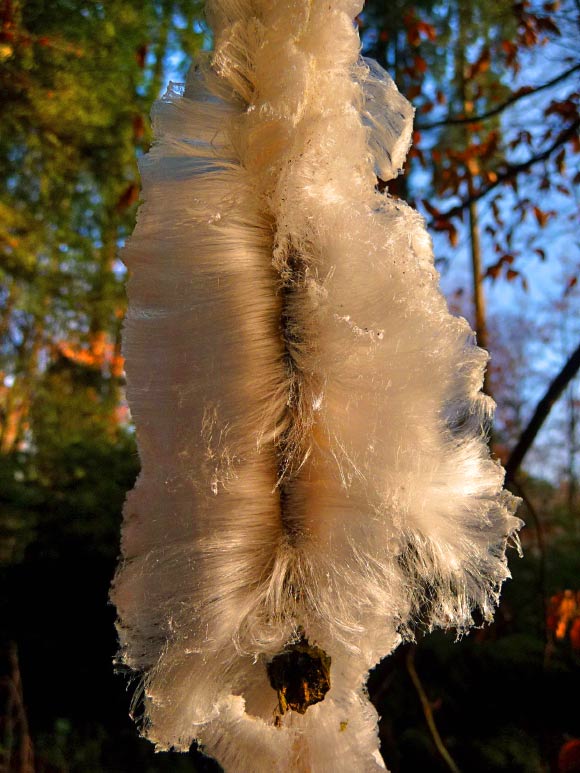A team of scientists, led by Dr Diana Hofmann of the Institute of Bio- and Geosciences in Jülich, Germany, has identified the missing ingredient that gives one of the most exciting types of ice, called hair ice, its peculiar shape: the fungus Exidiopsis effusa.

Hair ice on a stem of beechwood, hair length up to 10 cm. Image credit: D. Hofmann et al.
Hair ice, also known as ice wool, takes the shape of fine hairs – diameter near 0.02 mm, length up to 20 cm. It can be observed in forests, on dead wood, usually on the ground and sometimes on trees that are still standing.
According to Dr Hofmann’s team, hair ice grows on the surface of the unfrozen wood body of certain moist and rotten branches of broad-leaf trees. The hairs are smooth, often with a silky shine. They are found in bunches of beautiful structures such as curls and waves, sometimes with clear parting or zoning, but without ramification.
Although individual hairs are mostly separate, they follow a macroscopic order, often with surprising regularity.
The hair base is rooted at bark-free positions or where the bark is loose, but never on the bark. The outer end is either free or in contact with an ice crust or with surrounding material, such as bark or leaves. Sometimes hairs loop back to the branch. Bands of parallel hairs can sinter along contacting lines without losing the original shape until melt onset.
In cold, dry air, however, hair ice sublimates within a short time. Therefore it can be observed under calm, humid conditions only, at air temperatures slightly below 32 degrees Fahrenheit (0 degrees Celsius).
There are many reports on the observation of hair ice, mainly at latitudes between 45 and 55 degrees N in Canada, France, Germany, India, Ireland, Netherlands, Scotland, Slovenia, Sweden, Switzerland, USA, and Wales.
In a new study, Dr Hofmann and her colleagues from Germany and Switzerland confirmed a century-old hypothesis for the origin of this type of ice. They performed a set of experiments to figure out just what conditions are needed to grow hair ice and what its properties are.
German scientist Alfred Wegener was the first to study hair ice. In 1918, he noticed a whitish cobwebby coating on the surface of hair-ice-bearing wood, which his assistant identified as fungus mycelium – the mass of thin threads from where mushrooms grow. He suggested there was a relation between the ice and the fungus in the wood.
Some 90 years later, Gerhart Wagner, a retired Swiss professor who has been researching hair ice for decades, found evidence of this relation: treating the wood with fungicide or dunking it in hot water suppressed the growth of hair ice.
But the fungus species and the mechanism that drives the growth of hair ice was yet to be identified. That was the aim of Dr Hofmann and co-authors.
They studied samples of hair-ice-bearing wood collected in the winters of 2012-2014 in forests near Brachbach in western Germany.
They analyzed the wood samples using microscopic techniques and identified eleven different species of fungi.
“One of them, Exidiopsis effusa, colonized all of our hair-ice-producing wood, and in more than half of the samples, it was the only species present,” said Dr Gisela Preuss, a biologist from Germany and co-author on the study.
Study senior author Dr Christian Mätzler from the University of Bern in Switzerland performed experiments designed to better understand the physics of hair ice on samples he collected in a forest at Moosseedorf, Switzerland.
He found that the driving mechanism responsible for producing ice filaments at the wood surface is ice segregation.
“Liquid water near the branch surface freezes in contact with the cold air, creating an ice front and sandwiching a thin water film between this ice and the wood pores. Suction resulting from repelling intermolecular forces acting at this wood–water–ice sandwich then gets the water inside the wood pores to move towards the ice front, where it freezes and adds to the existing ice,” the scientists explained.
They then studied the hair ice itself. Chemical analyses of the melted ice showed the water to contain fragments of the complex organic compounds lignin and tannin.
Since these are metabolic products of the fungal activity, this finding further confirms the biological influence on hair ice.
The results were published online July 22 in the journal Biogeosciences.
_____
D. Hofmann et al. 2015. Evidence for biological shaping of hair ice. Biogeosciences 12, 4261-4273; doi: 10.5194/bg-12-4261-2015







